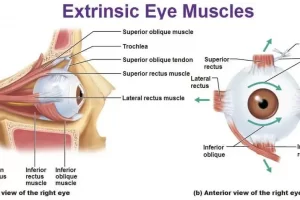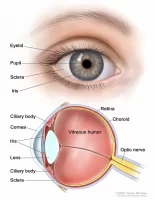Anatomy of the Eye
The eye has many parts that must work together to produce clear vision. If any part along the way is not functioning properly, our vision will be affected.
Cornea:
a clear window at the front of the eye that covers the iris and the pupil. When performing Lasik eye surgery, ophthalmologists use a laser to reshape part of your cornea to refocus it to direct light more accurately to the retina.
Choroid:
Located between the retina and sclera, the choroid is a thin membrane that supplies blood to the retina.
Ciliary Body:
The part of the middle layer of the eye that produces aqueous humour, a fluid that provides nutrition and maintains pressure in the eye.
Eyelid:
The skin folds that cover the eyeball when closed. Many conditions can affect the eyelids including chalazion, cysts, ectropion, entropion and blepharitis (eyelid inflammation).
Extrinsic Eye Muscles:
The muscles surrounding the eye that control the movement of the eye and eyelids.
Lens (Crystalline Lens):
located behind the pupil, acts like a camera lens by focusing light onto the retina at the back of the eye. It consists of a flexible gel held within a thin coating called the lens capsule. This is the part of the eye affected by cataracts, which occurs when the clear gel hardens as we age making it cloudly and more difficult for light to pass through it to create vision.
Optic Nerve:
Carries electrical signals from the retina to the brain where it is processed into our thoughts as vision. The optic nerve is the point of damage in most cases of glaucoma. Glaucoma is a group of eye conditions that cause pressure inside the eye. This can restrict blood flow to the optic nerve, weakening its structure, and resulting in a loss of vision.
Pupil:
The opening in the centre of the iris that lets light into the eye. The pupil changes in size to control the amount of light let into the eye.
Retina:
A layer of light-sensitive nerve cells that lines the back of the eye. The retina senses light entering through the eye and sends this information to the optic nerve through impulses. These signals are then sent to the brain to process the signals into vision. Some cases of diabetic retinopathy are caused by abnormal blood vessels growing on the surface of the retina, blocking light from reaching it. Macular degeneration is when part of the retina deteriorates causing loss of central vision.
Sclera:
The white of the eye. This outer layer protects the eye from injury and supports the eyeball’s shape. Extrinsic eye muscles are attached to the sclera to control the eye’s movement.
Iris:
The iris is included in the middle layer of the eye called the uvea. When part of the uvea or iris becomes inflamed, it is called uveitis. There are many causes of uveitis including an infection, rheumatoid arthritis or an eye injury.
Vitreous Humour:
The gel-like fluid that fills your eye. When clumps of the vitreous or cells stick together in the vitreous body and create floaters or flashes. These floaters block light from entering the retina, creating shadows or specks in vision.



